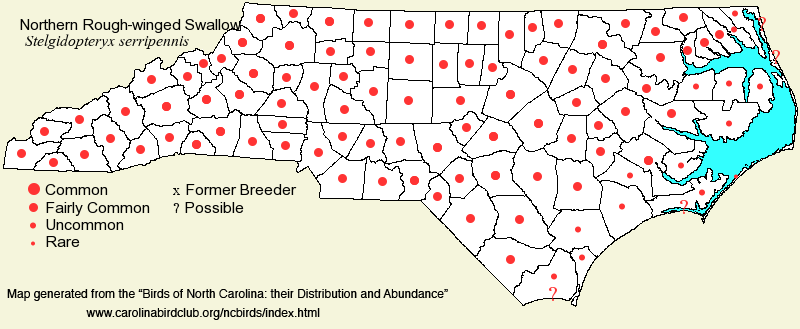 |  |
|
Northern Rough-winged Swallow - Stelgidopteryx serripennis HIRUNDINIDAE Members: | Search Common: Search Scientific: |
|
|
|||||||
| General Comments | This species, long known as the Rough-winged Swallow, had to have its common name changed several decades ago when the southern population (in the Neotropics) was split off as a separate species -- the Southern Rough-winged Swallow. Because the serrations on the wing are invisible to birders, it would seem better to just completely re-name both (with no more than three words). At any rate, this swallow -- like nearly all of those on the continent -- has a range from coast to coast, and it presumably nests in all 100 counties in the state, though it can be scarce near the coast. This scarcity is due to a paucity of vertical banks, as most nesting sites in the state are placed in banks that are 10 or more feet high. These banks are usually along the shore of a lake, but road-cuts, quarries, and other places will suffice, and they also nest in holes in man-made structures such as under bridges. They forage over nearby open areas, often around a lake or pond. As with the Purple Martin and Tree Swallow, they arrive well into Mar, and like the martin, they disappear by Aug, rarely lingering into early winter. However, with our warming winters in recent years, there has been a proliferation of birds lingering into the fist part of the season, at least into late Dec. | ||||||
| Breeding Status | Breeder | ||||||
| NC BRC List | Definitive | ||||||
| State Status | |||||||
| U.S. Status | |||||||
| State Rank | S4B | ||||||
| Global Rank | G5 | ||||||
| Coastal Plain | Summer resident. Fairly common over the inner two-thirds of the province, but uncommon to locally fairly common in Tidewater, and generally uncommon in coastal counties (and can be absent on coastal islands). Mainly mid-Mar to mid-Aug; often not arriving until Apr near the coast. Very rare straggler into Dec, and four records in Jan (as of 2023): at a quarry at New Bern on 14 Jan 1989, at a water treatment plant at Goldsboro on 29-30 Jan 2008, at a similar site at Ocean Isle Beach on 1 Jan 2010, and in Wilmington on 1 Jan 2011. Peak counts: | ||||||
| Piedmont | Summer resident. Fairly common over nearly the entire region, perhaps slightly more frequent near reservoirs and in the foothills (where there are roadcuts). Mainly mid-Mar to late Aug, very rarely into Oct, and rarely arriving as early as late Feb. Increasing straggler into early winter, with at least nine records: one on the Chapel Hill CBC, 24 Dec 2006; one at Lake Brandt (Guilford), 18 Dec 2013; one at Lake Crabtree (Wake), 10 Dec 2017; on at Angus Barn Pond (Wake), 21 Dec 2022; one on the Charlotte CBC, 26 Dec 2022; and one at Lake Crabtree, 31 Dec 2022. In Dec 2023 individuals were seen at two sites in Wake and one in Mecklenburg. Peak counts: | ||||||
| Mountains | Summer resident. Fairly common over the region, up to about 4,000 feet, and sparingly up to about 5,500 feet. Primarily late Mar to Sep, very rarely into Oct. Highly notable was one photographed at Ecusta Pond (Transylvania) on 11 Dec 2019, apparently a first mountain winter record; another was seen at that same site on 9 Dec 2021. Peak counts: | ||||||
| Finding Tips |
The species is normally seen in a day of birding in most sites away from coastal counties. The best places are large reservoirs, where most have a few swallows flying around near the shorelines from time to time. *** | ||||||
| Attribution | LeGrand[2024-05-14], LeGrand[2024-02-10], LeGrand[2023-05-19] | ||||||
| NC Map Map depicts all counties with a report (transient or resident) for the species. | Click on county for list of all known species. |
| NC Breeding Season Map Map depicts assumed breeding season abundance for the species. |  |